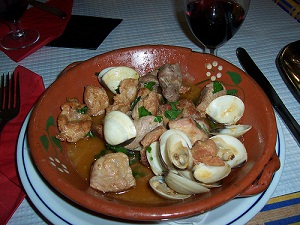The famous Portuguese food traditions reflect the energy of the Portuguese people and the climate in which they live. Read our guide for more facts & information…
Since the country of Portugal has an extensive coastline on the Atlantic Ocean and seafaring Portuguese sailors colonized the Azores islands and the far reaches of the world long ago, it comes as no surprise that seafood forms the basis of much of the famous Portuguese food tradition. The nation ranks fourth the world over for per capita fish consumption.
The Portuguese serve their fish grilled, poached, deep-fried, boiled, stewed in clay pots or roasted. Most common among the fish served and prepared within the Portuguese food tradition is the bacalhau (commonly called cod in English), with anchovies, swordfish, sole, sea bream, bass and salmon, as well as shellfish and molluscs, figuring prominently in traditional dishes. Because Portuguese food traditions had their inception before the development of modern refrigeration techniques cod and similar species are still prepared salted and dried, which also helps to preserve ancient traditions and cooking techniques.
Although Portugal itself does not border on the Mediterranean Sea at all, its traditional cuisine can be described as resembling Mediterranean cuisine rather closely. The emphasis is on fish, meat, olive oil, tomato, and spices. However the famous Portuguese food traditions are also influenced by cuisines encountered in the course of colonization in centuries gone by. This is particularly evident in the number and variety of seasonings employed. A prominent example includes the sauce called piri piri (from a Bantu language: literally, pepper) also known as African devil, or African red devil. Black pepper, saffron cinnamon and vanilla are also widely used.
As living conditions improved over time meat assumed an increasingly prominent position on the Portuguese table. Until the later Middle Ages it was virtually unheard of for all but the noble few to eat meat on a regular basis. More modern Portuguese cuisine has developed traditional meat dishes such as Alcatra, beef marinated in red wine and garlic. Humbler fare includes Tripas à moda do Porto, tripe with white beans, which dates from the 14th century.
The increasing variety and kinds of foods available has led to the creation of dishes that combine seafood, meat, vegetables and dairy products in tasty and starling ways. Pork and clams are combined in porco à alentejana (pork Alentejo-style). Pork is also cooked with mussels in a wok-like utensil called a cataplana, to produce na cataplana. In fact the hinged cataplana actually resembles a clam shell.
As far as vegetables go, tomatoes, cabbage, and onions appear most frequently in combination with meat and fish in soups and dishes that feature rice and potatoes. Although Portuguese cheese is traditionally made from goat’s or sheep’s milk a great many local varieties utilize cow’s milk with all sorts of spices added to create an almost endless variety of savory cheeses.
Succulent Portuguese pastries often consist mainly of eggs, sugar and flour with a surprising variety of flavors achieved by way of subtle seasoning and careful addition of ingredients such as fruit and nuts. Many pastry recipes trace their origins to the medieval monasteries that once dotted the countryside.





